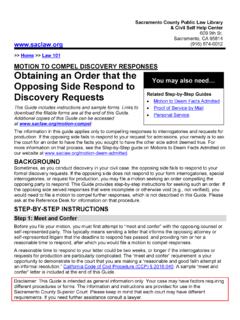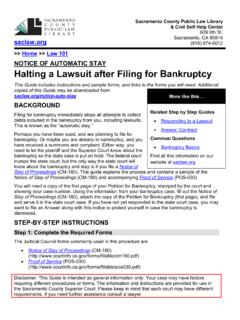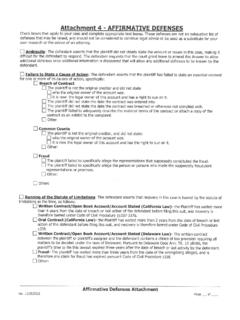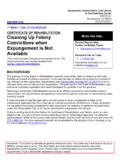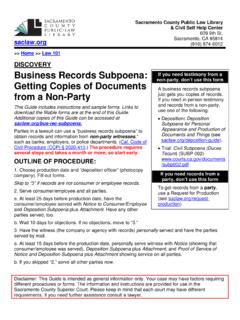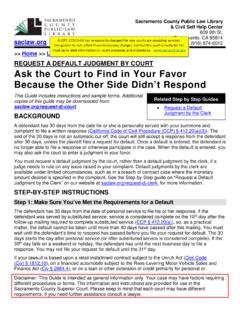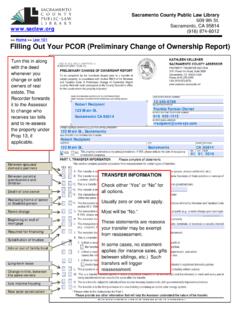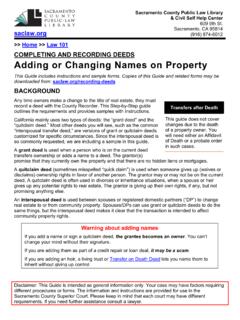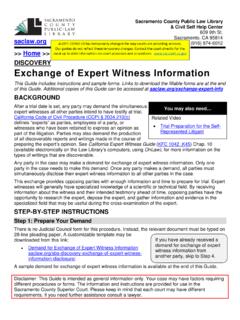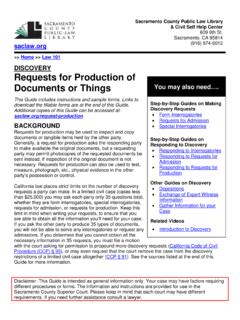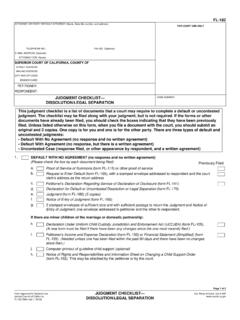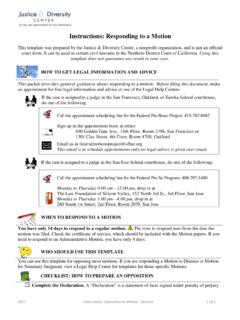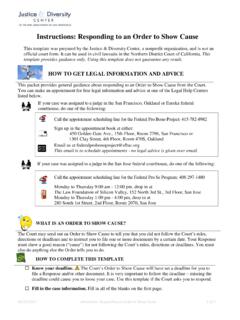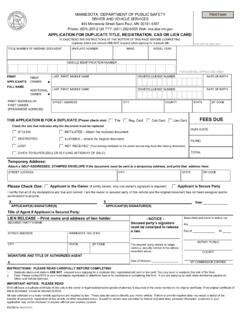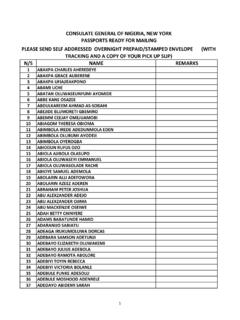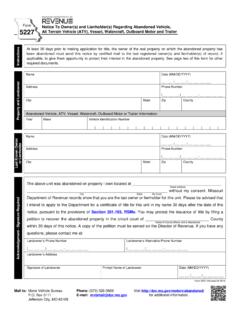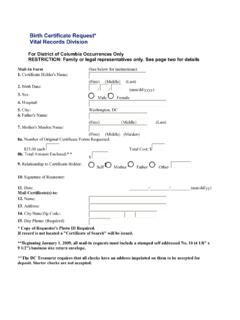Transcription of Depositions - Home | saclaw.org
1 >> Home >> Law 101 Disclaimer: This Guide is intended as general information only. Your case may have factors requiring different procedures or forms. The information and instructions are provided for use in the Sacramento County Superior Court. Please keep in mind that each court may have different requirements. If you need further assistance consult a lawyer. Sacramento County Public Law Library & Civil Self Help Center 609 9th St. Sacramento, CA 95814 (916) 874-6012 DISCOVERY Depositions This Guide includes instructions and sample forms. Links to download the fillable forms are at the end of this Guide. Additional copies of this Guide can be accessed at BACKGROUND A deposition is the taking of a statement of a witness or party under oath.
2 The deposing party (the asking person) may ask the deponent (the responding person) questions to obtain information, to discover what the party knows about a situation or event, and to determine what their testimony would be at trial. Although Depositions may be written or oral, this guide will only discuss the taking of oral Depositions . Each party may conduct one deposition of each other party. This limit is imposed to prevent parties from using the deposition process as a tool of harassment, and to make each party effectively use their deposition . Parties may also conduct Depositions of any relevant witnesses in the case. A party may only conduct one deposition of any individual, though. Taking an oral deposition is very expensive and time-consuming.
3 The party requesting a deposition is responsible for paying all costs and fees related to the deposition . With hiring a court reporter, transcribing the reporter s stenography, paying witness fees and travel expenses, etc., a short deposition can cost several hundred dollars or more! Because of this, many litigants prefer to use other discovery methods to obtain information and evidence. A very good discussion comparing Depositions to other discovery methods is found in Chapter 1 of Dunne on Depositions in California, KFC 1020 .Z9 D86, available on the Law Library s computers using WestlawNext. Chapter 2 of that book provides tips for minimizing the costs of Depositions . Step-by-Step Guides on Responding to Discovery Responding to Interrogatories Responding to Requests for Admissions Responding to Requests for Production Step-by-Step Guides on Making Discovery Requests Form Interrogatories Request for Production of Documents and Things Requests for Admission Special Interrogatories Other Guides on Discovery Exchange of Expert Witness Information Gather Information for your Case Related Videos Introduction to Discovery You may also Depositions >>Home >>Law 101 2 Although Depositions are expensive, they can be a very effective discovery tool.
4 In many cases, the benefits can far outweigh the costs. Depositions are extremely useful for: Recording a party or witness s story before trial so you may be better prepared for cross-examination at trial. Evaluating the credibility of a potential witness, or observing the impression they would make on the jury. Preserving testimony from a witness you suspect will be unfriendly or unavailable by the date of trial. Testimony given in a deposition may be used to impeach contradictory testimony given at trial. Obtaining additional information about physical evidence you ve already obtained by other discovery methods, or laying the foundation for admissibility of physical evidence at trial. Obtaining testimony and physical evidence from a non-party witness.
5 STEP-BY-STEP INSTRUCTIONS Step 1: Determine the Date and Location of the deposition California law provides very strict guidelines for the timing and location of Depositions . When scheduling a deposition , you must select a date that allows for adequate notice to the deponent and other parties. In most types of cases, for the deposition of a party to the case, you must provide at least 10 days notice if personally served, and 15 days notice if served by mail within California (California Code of Civil Procedure (CCP) (a), 1013). Additional time is required if service will be outside of California. For the deposition of a non-party witness, CCP (a) only requires service of a subpoena in sufficient time to allow the witness to travel to the deposition location, and locate any documents or items requested.
6 The law provides no definition of sufficient time, so unless there is considerable travel or an unusually large list of requested documents or items, it is usually reasonable to give the same notice you would give a party. CCP (a) also provides specific guidelines for the location of a deposition . When a natural person is being deposed, whether or not that person is a party to the case, you must conduct the deposition either a) within 75 miles of the deponent s residence, or b) within 150 miles of the deponent s residence and in the forum county. If your case is in Sacramento County, this means that you can hold your deposition in Sacramento County, as long as the deponent doesn t have to travel more than 150 miles from his residence to the deposition location.
7 If Sacramento County is more than a 150 mile trip, you will need to hold your deposition elsewhere, at a location no more than 75 miles from the deponent s residence. If you will be conducting a deposition of an organization that is a party to the case, the same rules apply, but distances are calculated from the organization s principal executive or business office. If the deponent is a non-party organization, you must take the deposition within 75 miles of the organization s principal executive or business office. Additional rules apply for Depositions of experts and out-of-state residents. The Law Library has rooms for rent that are appropriate for the taking of Depositions . Information about our rooms and rates is available on our website at Need deposition Space?
8 Depositions >>Home >>Law 101 3 When scheduling a deposition , you may also need to consider the availability of a court reporter, the deponent, and other parties. It is often advisable to contact the others in advance, to determine dates that are mutually convenient. This can help avoid the cost and hassle of rescheduling a deposition . Step 2: Complete the Proper Forms If deposing a party: If you wish to take the deposition of a party to the case, you will need to prepare a notice of taking of deposition . There is no fill-in-the-blanks form for this; you will need to write your own notice. A sample is at the end of this Guide. You may download a customizable template from this link: Notice of Taking of deposition Your notice must include the name of the deponent, as well as the date, time, and location of the deposition .
9 If the deponent is an organization, describe what matters you will be discussing, so that the organization may appoint a representative with the most knowledge of those issues. Describe any documents or other physical evidence you want the witness to bring to the deposition . In your notice, you must also indicate if you plan to audio or video record the testimony, and if you reserve the right to present the recording at trial. If your court reporter will be providing instant visual display stenography, often referred to as realtime deposition reporting, you must include notice of that, as well. If deposing a non-party witness: If you wish to take the deposition of a non-party witness, you will need to subpoena the witness.
10 The form you will need to use depends on if you want the witness to bring documents or things with them to the deposition . deposition Subpoena for Personal Appearance (SUBP-015). Use this form if you simply want a witness to appear to answer questions at a deposition . Instructions for completing this form are available at the end of this Guide. deposition Subpoena for Personal Appearance and Production of Documents and Things (SUBP-020). Use this form if you want a witness to appear to answer questions at a deposition , and to bring with them any documents or things. Instructions for completing this form are available at the end of this Guide. After completing the subpoena form, make a photocopy. Take the original and the photocopy to the court to have the subpoena issued ( stamped ) by the clerk.
